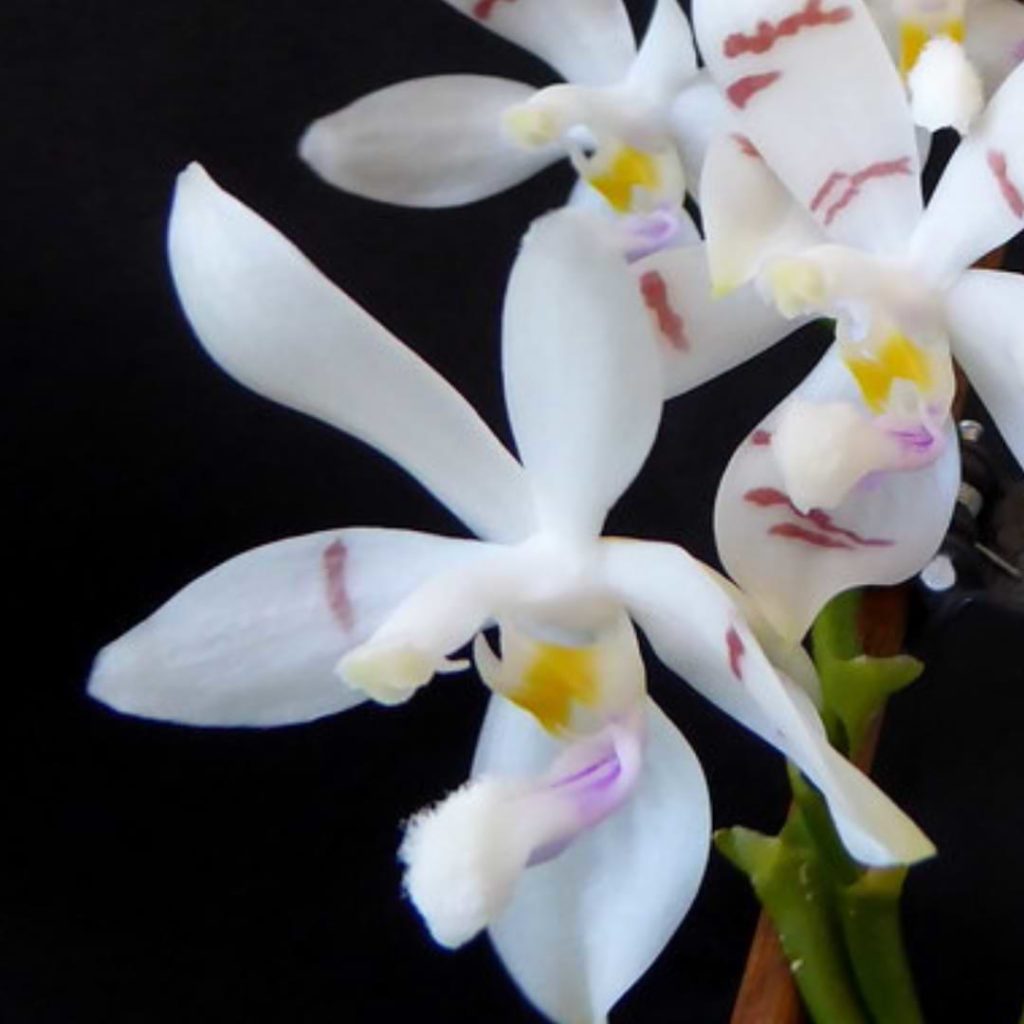Phalaenopsis tetraspis was first identified in 1870. This warm-loving orchid is native to the Andaman Islands, the Nicobar Islands, and northwest Sumatra. Sometimes Phal. tetraspis is referred to as The Four Shield Phalaenopsis.
While this species is not as showy as some other orchid species, it is popular among orchid collectors. The flowers are dainty and pretty rather than big and vibrant. If the former describes the type of orchid you are looking for, then Phal. tetraspis is a great option.
Although tetraspis is a phalaenopsis, it differs somewhat from other orchids in the Phalaenopsis genus. Phal. tetraspis needs care that might seem unusual if you are already used to caring for other phalaenopsis.
Although this orchid is a bit pickier than the average phalaenopsis, don’t worry. Caring for Phal. tetraspis isn’t too difficult as long as you know what it needs. Keep reading to learn more about Phalaenopsis tetraspis and how to take care of it.
How to Grow Phalaenopsis Tetraspis
Phalaenopsis orchids are usually considered the easiest orchids to care for; however, Phal. tetraspis is one of the more finicky species within the Phalaenopsis genus.
This species requires more warmth and humidity than other phalaenopsis, but it’s still entirely possible for Phal. tetraspis to thrive in your home. You just need to pay a little more attention to environmental conditions indoors than you would with other phalaenopsis.
Beginners do not usually choose Phal. tetraspis as their first orchids, but it’s a popular choice for orchid owners looking to grow their collection.
Light
Phal. tetraspis needs indirect light. If only direct sunlight is available from windows, use a sheer curtain to filter the light.
In order to bloom during the spring and summer, this orchid needs at least 12 hours of light. You may need to supplement with artificial light depending on the natural light available in your home.
Temperature & Humidity
Phal. tetraspis are warm-growing orchids. They prefer temperatures between 65-75 degrees Fahrenheit at night and 80-90 degrees Fahrenheit during the day.
These orchids cannot handle much time in cooler temperatures, so avoid letting the temperature drop below 65 degrees to reduce the risk of damage. Keep Phal. tetraspis away from drafty windows and doors, especially during the winter months.
For humidity, you probably won’t be able to match the conditions of this orchid’s natural growing environment. Instead, aim to keep the humidity around the orchid at 50% or higher.
You can raise the humidity level in several ways: try placing your orchid over a humidity tray filled with water or group several plants together to form a more humid microclimate indoors. If these options aren’t enough, you might need to use a humidifier to keep Phal. tetraspis thriving indoors.
How Much Water Does Phalaenopsis Tetraspis Need?
The watering schedule for Phal. tetraspis depends on many different factors. The best way to keep this orchid watered correctly is to check the growing medium. Phal. tetraspis should be watered when the growing medium is almost dry. Use your finger to feel the growing medium to check whether or not it’s time to water.
You can also look at the roots to see if your watering schedule is on track. Most of the time, your orchid’s roots should be light green or white. Bright green roots have recently been watered and don’t need additional moisture; if you water bright green roots, you risk overwatering your orchid.
If you’ve gone too long without watering, the roots will begin turning crispy and brown. You need to water orchids with crispy, brown roots immediately and begin watering more frequently in the future.
If you are growing your Phal. tetraspis in a pot, you should be watering roughly once a week depending on environmental conditions. Be sure that the container has drainage holes to allow excess water to escape.
Some growers prefer to mount Phal. tetraspis rather than grow it in a container. This method requires watering daily or every other day, but you are less likely to overwater or underwater your orchid if it is mounted.
Regardless of whether your orchid is grown in a container or mounted, water it in the morning. This allows water that splashes on the leaves or crown to evaporate and prevents crown rot.
Orchid Soil
Selecting a good growing medium for your orchid is critical for its survival. Orchids cannot survive in regular potting soil because it’s too dense, holds on to too much water, and can suffocate the roots.
To successfully grow Phalaenopsis tetraspis in a container, you need a growing medium that is lightweight and drains quickly. Look for a quality potting mix designed for orchids that contains tree bark.
Be sure to use fresh soil when you repot your Phal. tetraspis every year or two. Over time the bark in the potting mix breaks down, making the old potting mix too dense for your orchid.
Phal. tetraspis grown on a mount won’t require a potting mix, but you will need to wrap sphagnum moss around the roots. The moss will hold on to water and allow the roots to take up moisture as needed. As the orchid becomes established on the mount, the moss will eventually fall away. This is normal because the orchid will no longer need the moss once it adjusts to the transition from a container.
Fertilizer
For your orchid to thrive indoors, it needs fertilizer. Unlike outdoor orchids, indoor orchids only have access to limited nutrients, so you’ll need to supplement with fertilizer.
Choose a balanced fertilizer for your orchid, one where the NPK ratios (the amounts of nitrogen, phosphorus, and potassium) are even. For example, 10-10-10 or 15-15-15 are balanced fertilizers.
For easy fertilizing, choose a gentle, diluted fertilizer that allows you to control how much fertilizer you apply. Overfertilizing can burn your orchid’s roots, so it’s better to start off with a smaller application of fertilizer. You can always increase the amount later if needed.
Phalaenopsis Tetraspis Flowers
Expect Phal. tetraspis to flower in the spring or summer. Blooming continues anywhere from 1 to 6 months depending on environmental conditions.
The flowers are a combination of red and white with a variety of patterns. The patterns are random and can differ from flower to flower even on the same plant. Phal. tetraspis has revolving blooms, which means that new blooms appear as old blooms begin to fade. In general, each flower lasts between 5-10 days before fading.
The Phal. tetraspis flower has a pleasant, fruity fragrance commonly compared to the smell of mango.
Popular Phalaeonopsis Tetraspis Hybrids
The main difference in Phalaenopsis tetraspis varieties is the color pattern of the flowers. Most flowers are ivory white along with a reddish color. There are not too many hybrids for this orchid.
There’s also some debate over the classification of tetraspis versus speciosa. Some taxonomists think that Phal. tetraspis is a variety of Phal. speciosa while others argue that the two are separate species.
Snow Twinkle: A cross between Phal. tetraspis and Phal. Aphrodite, this plant has white flowers with a light arrangement of small purple spots on its petals. This attractive cross does not have any fragrance.
Li Sun High: This hybrid (Phal. mariae x Phal. tetraspis) is considered an easy-to-care-for orchid despite both its parents being more difficult orchids. The flowers have a white base with yellow, brown, or reddish spots. The blooms are long-lasting and have a unique sweet smell.
Jennifer Palermo: For a more vibrant hybrid, take a look at Jennifer Palermo. A cross between Phal. tetraspis and Phal. violacea, this hybrid has beautiful blue or violet flowers that are slightly larger than Phal. tetraspis flowers are normally.
How to Mount Phalaenopsis Tetraspis
Phalaenopsis tetraspis are epiphytes, which means that in the wild they grow anchored to other plants rather than in the ground. Generally, epiphytic orchids attach themselves to trees in the natural environment.
While it isn’t a requirement to mount Phal. tetraspis, some owners find that mounting this species makes care easier. If you have not grown an orchid in a mount before, the process might seem challenging, however, it’s not too difficult.
Here’s what you need to do to mount Phalaenopsis tetraspis:
Materials
- Mount (cork is popular)
- String (or fishing line)
- Sphagnum moss
Step 1: Pick the mount.
Most growers use cork mounts for orchids. Although there are other options like tree branches or wood slat plaques, you should start with a cork mount if you’ve never had a mounted orchid before.
Think about how you will hang the mount in your home. Most growers hang cork mounts like a picture frame. However, there may be other options that work well in your space.
Step 2: Prepare the orchid.
Let your orchid soak in water for about 20 minutes. Remove any old growing medium that is still clinging to the orchid’s roots.
During this time, go ahead and allow the sphagnum moss to soak as well. After 20 minutes, remove the moss from the water. Squeeze it a little bit to get rid of excess water.
Step 3: Attach the orchid to the mount.
Place the sphagnum moss on the mount with the string or fishing line. Cut-up pantyhose also works for attaching the pieces together.
Then place your orchid’s roots on the mount. Put a thin layer of sphagnum moss over the top of the roots. You’ll remove the moss once the orchid has adjusted to being mounted.
Use a string or fishing line to attach the orchid to the mount. You’ll also be able to remove the string or fishing line later on. The orchid will eventually grow enough to be able to hold itself to the mount.
Step 4: Water your orchid frequently.
Mounted orchids have to be watered more often than potted orchids. Plan to water your orchid every day most of the time.
To water, bring the mount to the sink and run water over the orchid. While this may be an extra step, you won’t have to worry about overwatering a mounted orchid. Since overwatering is the most common reason why houseplants die, you’ll have one less problem to think about!
Some growers mist their orchids every day rather than bringing the mount to the sink. I’d steer away from this method because it’s harder to keep your orchid watered properly this way. (This doesn’t mean you can’t do it, but you would just need to be very certain how much water your orchid needs.)
Phalaenopsis Tetraspis Plant Care FAQ
Why do my Phalaenopsis tetraspis have different flowers?
Different flowers on the same Phal. tetraspis can have different patterns. Some flowers will have more red petals than others. Some may just have spots. Differences in temperature and sunlight are believed to be the reason why this occurs.
Should I cut off the spikes on my Phalaenopsis tetraspis?
Phal. tetraspis produces new flowers as old flowers fade. Do not cut off the flower spikes while they are still green and healthy; otherwise, you will miss out on new blooms.
Join Our Orchid Care Facebook Community
In our Facebook group of orchid lovers, we’re dedicated to creating a rich and engaging environment where plant lovers can come together and share tips, tricks, and experiences.
If you’re an orchid lover, come join our Facebook community! We can’t wait to celebrate your successes and help you troubleshoot your care routine.
For continued success, you can explore our other articles or visit our online shop for plant care products that are sure to keep your plants boasting rich green leaves and big, bountiful blooms year-round.



